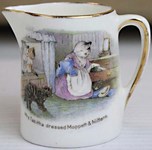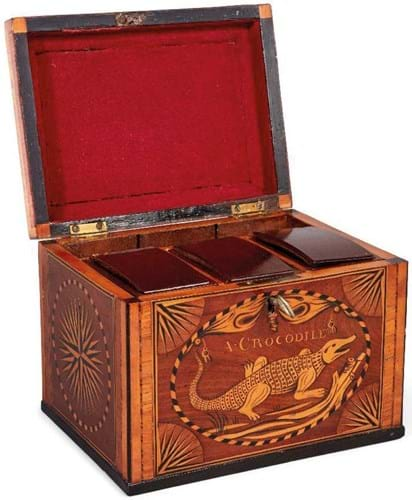
Kennard, who died last year aged 100, still lived in the central London apartment in which he was born.
A close friend offered the following memories: “You never visited Herbert but were rather received by him, as he was always seated in a large armchair in his entrance hall.
“Time keeping was paramount. Five minutes early was unacceptable, and 10 minutes late was a total disaster. Herbert’s collecting seemed to have started in earnest, some 40 years ago, when Helen, his governess, passed away. He adored her, but she didn’t like the idea of Herbert collecting.”
Kennard, whose interests included opera and ballet, had a great affection for 18th century English furniture and associated works of art.
His 363-lot collection acquired through leading dealers and at top fairs, had been well chosen and enjoyed a selling rate of 98%, albeit against estimates that were sometimes just 10% of the retail prices he had paid.
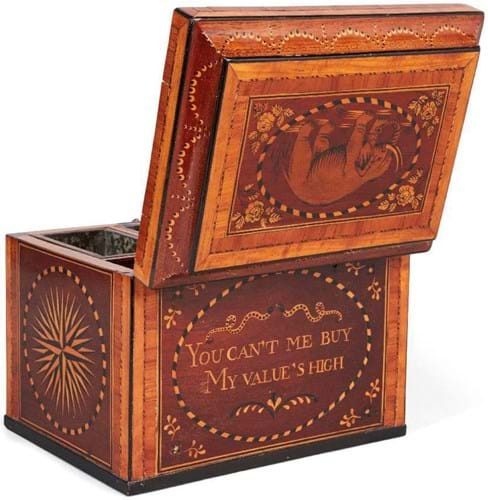
Comfortably the most desirable of more than 40 tea caddies, most of them guided at under £200 each, was a George III inlaid satinwood marquetry three-division example, c.1800, he had bought from Edenbridge dealer Lennox Cato in 2014.
A generous size and in good condition, it was inlaid to the lid with an elephant and to the side with a crocodile. The inscription inlaid to the back reads You Can’t Me Buy My Values High.
Numerous phone lines booked to compete at the estimate of £1000-2000 but it went on to realise a £11,000, the top price of the sale.
Tea caddy time
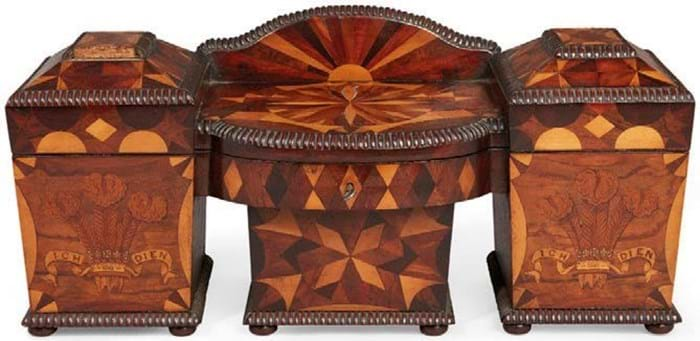
Walnut and parquetry ‘sideboard’ form tea caddy – £900 at Roseberys.
A very pretty George III satinwood oval two-division tea caddy, inlaid with ribbon-tied musical trophies and flowers, also bought in 2014 (from Walton House Antiques in Mere) sold at £2200. Historically more modest sums of £900 and £1100 each came for paper scrolled caddies, one dated 1795, the other set with a watercolour portrait of a woman.
Another rarity was an early 19th century walnut and parquetry ‘sideboard’ form tea caddy just under 19in (46cm) wide and inlaid to the pedestals with the Prince of Wales feathers and the motto Ich Dien. It was a bargain at £900.
Idiosyncratic taste
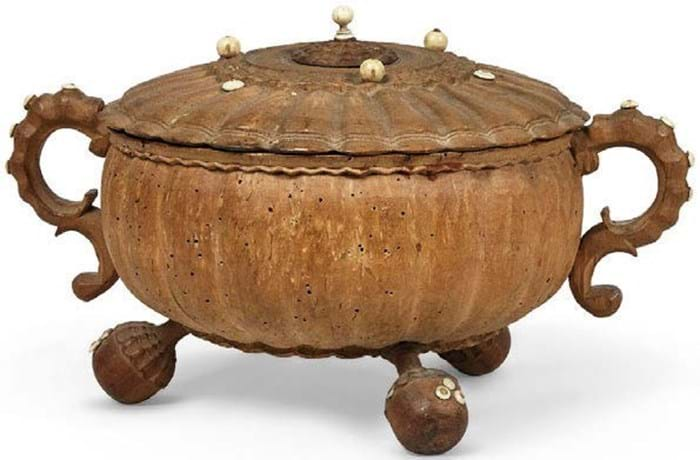
A 17th or 18th century birch and bone kallskal – £3800 at Roseberys.
Just two days earlier (March 24) the West Norwood firm had offered another single-vendor sale – 421 lots from the well-known dealer Ted Few. Some 83% of entries were sold.
‘Idiosyncratic’ is the word often used to describe Few’s taste and stock in trade.
Established in business in 1975, the BADA and LAPADA member is well-known for his period ‘mash-ups’ and ‘cabinet-of-curiosities’ displays that bring together artworks as varied as modern British pictures, treen, folk art and formal sculpture.
He is among a number of well-respected dealers who have chosen to sell at auction at a time when fairs and shops were closed and face-to-face trading difficult.
Typical of Few’s kunstkammer taste, and among the best-received pieces, was a 17th or 18th century Swedish kallskal made in burr birch with bone mounts that carried an inscription to the cover suggesting a royal provenance.
In ink is written Donné par le Roi Charles XV a Ulriksdal Vaisselle de Campagne de Gustave Adolphe 12 Aut 1863 – a reference to the Ulricksdal royal palace, north of Stockholm, acquired in 1856 by Prince Charles, later King Charles XV.
During his reign the palace was used as his preferred summer residence and furnished extensively with antiques. The mention of Gustave Adolphe perhaps refers to Gustav IV Adolph, king of Sweden from 1792-1809.
Estimated at £300-500, it sold for £3800.



